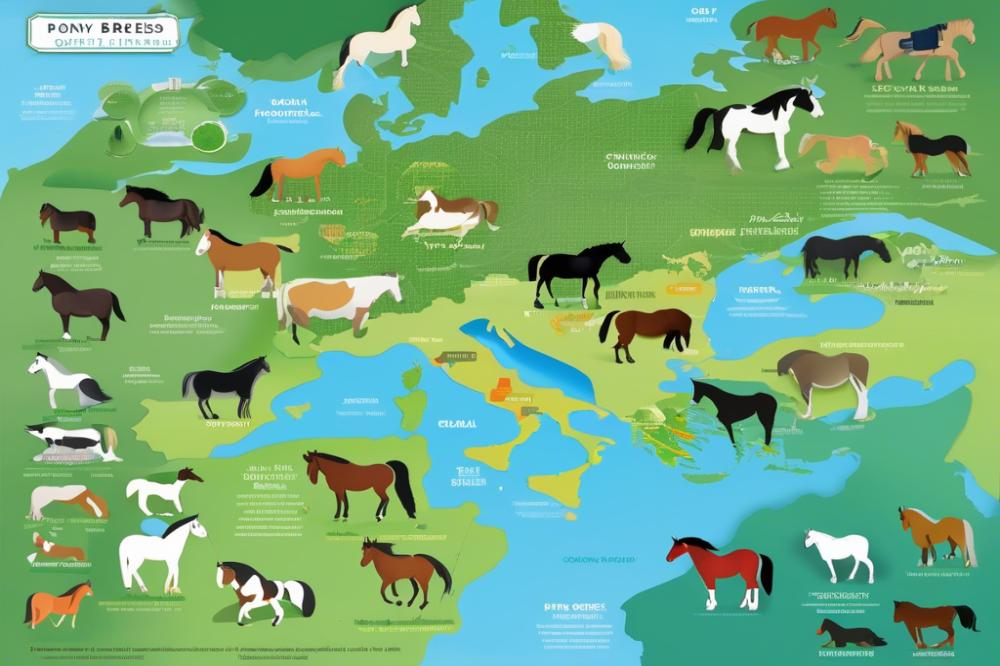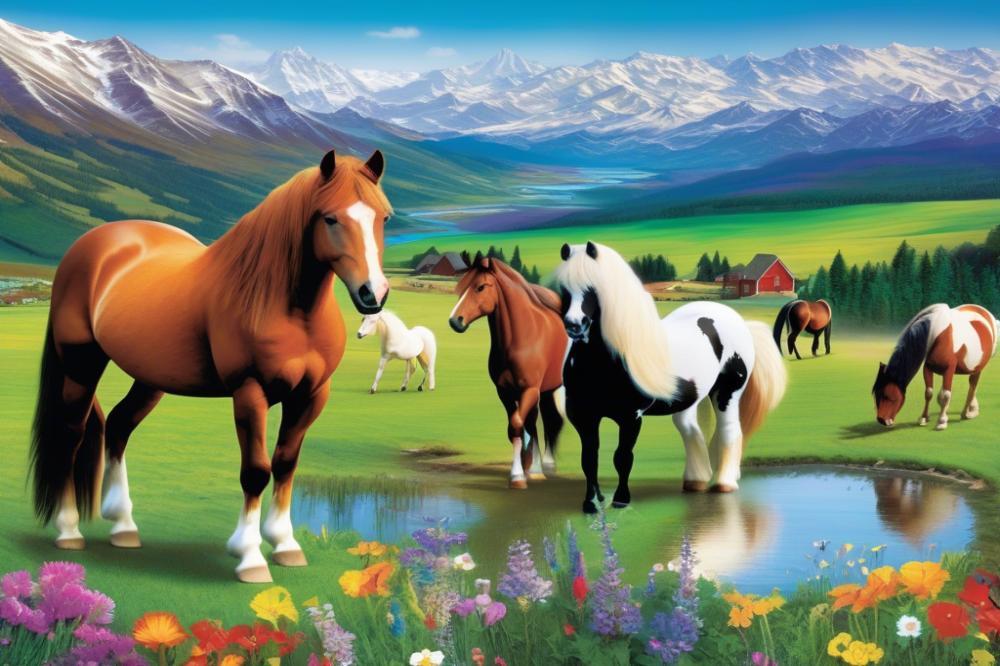Introduction
Pony Breeds can be found across the globe, and each one possesses distinct traits shaped by their environments. From the hardy Shetland ponies of the rugged Scottish Isles to the elegant Connemara ponies of Ireland, these animals showcase the remarkable diversity that exists within equine breeding. Factors such as terrain, weather, and available resources play a crucial role in determining their development.
The importance of climate and geography in their evolution cannot be overstated. Different regions have unique conditions that have influenced how these animals grow, behave, and thrive. For instance, ponies developed in cold, mountainous areas often have thicker coats and robust bodies. Conversely, those raised in warmer climates might exhibit leaner physiques and lighter builds. Such adaptations are vital for survival in their natural habitats.
This article aims to explore the intricate relationships between climate, geography, and the various Pony Breeds around the world. Understanding how these factors intersect provides valuable insights into equine history and breeding practices. Insights gained can help us appreciate the resilience and versatility of these remarkable creatures, reminding us of the enduring bond between animals and their environments.
The Role of Geography in Pony Breed Development

Geography plays a significant role in shaping animal breeds. Different ecosystems across the world create environments that influence how species adapt. Climate, terrain, and available resources all contribute to the development of these animals. Where ponies live often determines their physical traits and behaviors.
Variability in ecosystems presents a milder climate in some areas and harsher conditions in others. Mountainous regions, for instance, might develop ponies with sturdier legs and thicker coats. In contrast, coastal areas may produce breeds that are lighter and more agile. This basic adaptability is key to survival and success.
Different environments lead to distinct physical characteristics in ponies. In colder climates, animals often acquire dense fur for warmth. Ponies in marshy areas might develop webbed hooves to navigate muddy terrain. Such adaptations ensure they thrive in their specific habitats.
Examples can be found across the globe. The Shetland Pony showcases impressive resilience, thriving in the cold winds and rough landscapes of the Shetland Islands. Meanwhile, the Connemara Pony flourishes in the lush, rolling hills of Ireland. Each breed reflects the local conditions that shaped its evolution.
Breeds are not random; they mirror their surroundings. Nutritional requirements may differ based on what is available in the region. Additionally, local culture often influences training and usage, impacting pony temperaments. Thus, where a pony is raised tells a rich story about its lineage.
This link between geography and breed traits emphasizes the importance of habitat. Different regions nurture unique combinations of traits. Ponies may have charm and elegance in one area, while robustness and strength could characterize another. These distinctions not only highlight diversity but also accentuate the intricate connection between climate and animal development.
Climate Factors Influencing Pony Breeds

Impact of Temperature and Weather on Pony Adaptation
Temperature plays a crucial role in how ponies adapt to their environment. In colder regions, ponies develop thick coats to protect themselves from harsh winters. Their bodies tend to be stockier and more compact. This build helps them conserve heat. In contrast, warmer areas often feature ponies with lighter coats to cope with the heat. Adaptation goes beyond just physical traits. Behavioral changes also occur, such as seeking shade or grazing during cooler hours. These adjustments help them thrive in diverse climates.
Breeding Practices Reflecting Climatic Conditions
Breeding practices often reflect the local climate and terrain. Farmers may select for traits that are specifically beneficial in their region. In areas with heavy snow, breeders often favor strong legs and hardy bodies. Such features help ponies navigate tough landscapes. Conversely, in milder climates, speed and agility may be more valued. They might prioritize traits that enhance work efficiency or riding performance. The choices made by breeders demonstrate how closely intertwined climate and animal development can be.
Case Studies of Ponies in Harsh Versus Temperate Climates
Ponies in harsh climates face different challenges compared to those in temperate zones. In extreme environments, survival depends on resilience. These ponies often have protective adaptations that equip them for tough conditions. In contrast, those in temperate areas may flourish in milder temperatures and richer pastures. While both types of ponies are bred with care, their specific traits often reflect their unique environments. Understanding these differences provides insight into the impact of climate on equine life.
Historical Context of Pony Breeds
Throughout history, the evolution of pony breeds reflects the intertwined relationships between humans, animals, and the environments they inhabit. Different regions shaped these animals, leading to diverse characteristics based on their needs. For instance, ponies in mountainous areas developed sturdy bodies to navigate tough terrain. On the other hand, those in coastal regions became more adaptable to wet conditions.
The movement of people also played a significant role in shaping pony breeds. As humans migrated across continents, they took their animals with them, mixing different breeds and traits. Ships transporting goods often included ponies, leading to transfers between distant lands. Trade routes facilitated the exchange of not just products, but also breeding ideas and practices. This blending resulted in some breeds becoming more recognized while others faded away.
In many regions, local pony breeds have been preserved due to cultural significance. In remote areas, traditional practices often protect these native ponies from outside influences. Communities value these animals for their unique characteristics, which have developed over centuries. This preservation helps maintain genetic diversity and protects the historical lineage of these ponies.
Environmental factors have also influenced how these breeds developed. Climatic conditions, such as temperature and rainfall patterns, determined what ponies would eat and how they would adapt to their surroundings. In colder climates, ponies grew thicker coats for insulation, while in warmer areas, they became more streamlined. This adaptation was crucial for survival, allowing them to thrive in various ecosystems.
Understanding how climate and geography shaped these equine companions shows the deep connection between humans and nature. The story of pony breeds is not only about horses but also about the cultures that have nurtured them. Various aspects, from human migration to the need for specialized traits, come together to form a rich tapestry of history.
Global Pony Breeds and Their Unique Adaptations
Ponies from all corners of the globe showcase a variety of adaptations shaped by their environments. Each breed reflects the specific needs of the people and landscapes they inhabit. From the frigid climates of the northern plains to the arid deserts of the south, geographical conditions play a key role in their development.
Distinct Breeds
The Shetland Pony hails from the rugged Shetland Isles in Scotland. This breed has a thick coat, which protects it from harsh winds and cold temperatures. Strong and hardy, Shetlands are used for both work and companionship, demonstrating their versatility.
In contrast, the Akhal-Teke, native to Turkmenistan, possesses a sleek, shiny coat. This breed thrives in arid regions where heat can be extreme. Their thin skin allows for effective heat dissipation, making them well-suited to desert conditions.
The Welsh Pony, originating in Wales, further illustrates the diversity of these animals. Adapted to hilly terrains, they exhibit strength and agility, making them excellent for both riding and farming. Their friendly temperament has also made them a favorite among children.
Local Adaptations
Geography shapes not just physical traits but also behaviors. Highland Ponies, found in Scotland’s Highlands, are compact with strong legs. These characteristics help them navigate rocky landscapes. Their resilience in tough conditions is remarkable, enabling them to find food and shelter in austere environments.
The Mongolian Pony, rooted in the vast steppes of Mongolia, showcases adaptations for endurance. These skilled animals can travel long distances in search of grazing. They have developed a rich coat, providing insulation against the severe temperature fluctuations typical of their region.
Cultural Significance
Ponies hold a deep cultural significance in various societies. In Mongolia, they are not merely animals but are integral to the nomadic lifestyle. Families rely on them for transport, herding, and as a vital food source. Festivals celebrating horsemanship highlight their importance in these communities.
In the United States, the Chincoteague Pony is tied to a local legend. Each summer, a swim across the ocean draws attention to their unique history and connection to the island. This breed symbolizes the heart and spirit of Pony Penning Day when their annual auction takes place.
Urban settings also recognize the role of smaller breeds. Miniature Ponies often serve as therapy animals. Their gentleness and small size help them connect with people, especially children, providing emotional support and joy.
Modern Breeding Practices and Their Impact
Current trends in breeding reflect a mix of tradition and innovation. Breeders strive to meet modern demands while holding onto the history of different horse breeds. Many focus on traits that improve performance and health. This can lead to a dominance of certain characteristics, potentially overshadowing native stock. A desire for speed and agility drives some decisions, while the uniqueness of local ponies risks being lost.
Balancing conservation with progress poses a challenge for those involved in the breeding process. Native ponies possess qualities developed over generations, making them well-suited for local environments. Protecting these breeds provides ecological balance and supports regional identities. Yet, modern expectations often pull breeders toward more popular, commercially viable horses. The push for uniformity can threaten the genetic diversity treasured within traditional breeds.
Climate change introduces additional hurdles for future adaptations. Shifting weather patterns affect pasture availability and the health of these animals. Breeders must consider how rising temperatures and harsher conditions impact pony resilience. Developing breeds that can withstand these changes is crucial for survival. Innovation in breeding practices must take these realities into account.
Many breeders are now integrating sustainable practices, shaping the future of equestrian efforts. Embracing eco-friendly approaches can help maintain genetic diversity while ensuring the health of the land. Working alongside local ecologists, some practitioners aim to create a harmonious relationship between ponies and their environment. More education on the environmental impact of breeding decisions is needed. Understanding these aspects will guide more informed choices in the years to come.
Final Thoughts on Climate and Geography’s Role in Pony Development
Climate and Geography’s Impact on Pony Breeds
Climate and geography have played a crucial role in shaping various horse breeds around the world. Distinct environments push ponies to adapt in unique ways. For instance, ponies in frigid climates often develop thicker coats for warmth, while those in arid regions become more resilient to heat and scarce water. Such environmental pressures have led to the creation of diverse traits that define each breed. Thus, the connection between these animals and their surroundings is both deep and complex.
The Need for Preservation
Preserving native ponies is vital, especially in a world where climates are changing rapidly. As temperatures fluctuate and weather patterns shift, some breeds may struggle to survive. Efforts must focus on protecting these breeds for future generations. They hold cultural significance and represent the heritage of specific regions. Without proper conservation, we risk losing this valuable biodiversity. Supporting native breeds will ultimately benefit not just the animals, but also the ecosystems and communities that depend on them.
Future Directions for Research and Breeding Practices
Looking ahead, research needs to explore how changing environments will impact horse breeds. Breeders should develop practices that consider the long-term survival of these animals in shifting climates. Innovations in breeding techniques and genome understanding can help create resilient populations. Collaboration between scientists, conservationists, and breeders is essential for ensuring the future of these ponies. Understanding how external factors influence genetics will provide insight into the best practices for breeding.
In summary, climate and geography significantly influence pony breeds. Recognizing the importance of these animals and their adaptations is crucial in our changing world. By preserving native ponies and exploring new research pathways, we can safeguard their future for both the earth and equestrian lovers worldwide.



